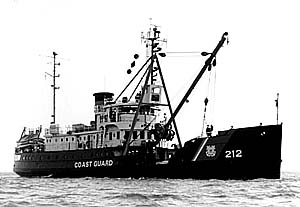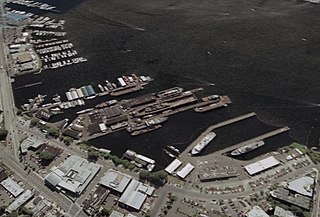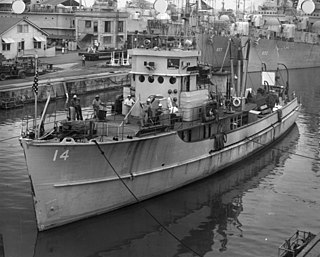
Vigor Shipyards is the current entity operating the former Todd Shipyards after its acquisition in 2011. Todd Shipyards was founded in 1916, which owned and operated shipyards on the West Coast of the United States, East Coast of the United States and the Gulf. Todd Shipyards were a major part of the Emergency Shipbuilding Program for World War II.

Moore Dry Dock Company was a ship repair and shipbuilding company in Oakland, California. In 1905, Robert S. Moore, his brother Joseph A. Moore, and John Thomas Scott purchased the National Iron Works located in the Hunter's Point section of San Francisco, and founded a new company, the Moore & Scott Iron Works Moore had previously been vice president of the Risdon Iron Works of San Francisco. Scott was nephew to Henry T. and Irving M. Scott, owners of the nearby Union Iron Works, where John had risen from apprentice to superintendent. Their new business was soon destroyed by fire resulting from the San Francisco earthquake.

Lake Union Drydock Company is a full-service shipyard that specializes in vessel repair and conversions located in Seattle, Washington. Drydocking vessels up to 6000 tons, Lake Union Drydock Company repairs factory trawlers, fishing vessels, Coast Guard Cutters and buoy tenders, tugboats, research vessels, ferries, mega-yachts, barges, and houseboats.

The four Richmond Shipyards, in the city of Richmond, California, United States, were run by Permanente Metals and part of the Kaiser Shipyards. In World War II, Richmond built more ships than any other shipyard, turning out as many as three ships in a single day. The shipyards are part of the Rosie the Riveter/World War II Home Front National Historical Park, whose Rosie the Riveter memorial honors the shipyard workers. Shipyard #3 is listed on the National Register of Historic Places and is a California Historical Landmark # 1032.

General Engineering & Dry Dock Company was a shipbuilding and ship repair company in Alameda, California that was active from the 1920s through the 1940s. The company built ships for the Southern Pacific Railroad and the United States Coast Guard in the late 1920s and early 1930s and took part in the World War II shipbuilding boom, making diesel-propelled steel hulled auxiliaries for the United States Navy, primarily oceangoing minesweepers.
John H. Mathis & Company was a shipbuilding company founded around 1900, based at Cooper Point in Camden, New Jersey, U.S, on the Delaware River. At their shipyard at Point and Erie Streets, the company built luxury yachts and also commercial ships. During World War II a variety of Naval vessels were built. The Mathis shipyard closed in 1961.

The Type V ship is a United States Maritime Commission (MARCOM) designation for World War II tugboats. Type V was used in World War II, Korean War, and the Vietnam War. Type V ships were used to move ships and barges. Type V tugboats were made of either steel or wood hulls. There were four types of tugboats ordered for World War II. The largest type V design was the sea worthy 186-foot (57 m) long steel hull, V4-M-A1. The V4-M-A1 design was used by a number of manufacturers; a total of 49 were built. A smaller steel hull tugboat was the 94-foot (29 m) V2-ME-A1; 26 were built. The largest wooden hull was the 148-foot (45 m) V3-S-AH2, of which 14 were built. The smaller wooden hull was the 58-foot (18 m) V2-M-AL1, which 35 were built. Most V2-M-AL1 tugboats were sent to the United Kingdom for the war efforts under the lend-lease act. The Type V tugs served across the globe during World War II including: Pacific War, European theatre, and in the United States. SS Farallon, and other Type V tugs, were used to help built Normandy ports, including Mulberry harbour, on D-Day, 6 June 1944, and made nine round trips to Normandy to deliver Phoenix breakwaters.

California during World War II was a major contributor to the World War II effort. California's long Pacific Ocean coastline provided the support needed for the Pacific War. California also supported the war in Europe. After the Japanese attack on Pearl Harbor on December 7, 1941, most of California's manufacturing was shifted to the war effort. California became a major ship builder and aircraft manufacturer. Existing military installations were enlarged and many new ones were built. California trained many of the troops before their oversea deployment. Over 800,000 Californians served in the United States Armed Forces. California agriculture, ranches and farms were used to feed the troops around the world. California's long coastline also put the state in fear, as an attack on California seemed likely. California was used for the temporary and permanent internment camps for Japanese Americans. The population grew significantly, largely due to servicemen who were stationed at the new military bases/training facilities and the mass influx of workers from around the U.S. in the growing defense industries. With all the new economy activity, California was lifted out of the Great Depression. Over 500,000 people moved to California from other states to work in the growing economy. California expanded its oil and mineral production to keep up with the war demand.

Fellows & Stewart Inc. was a shipbuilding company in San Pedro, California on Terminal Island's Pier 206. To support the World War II demand for ships Fellows & Stewart built Crash rescue boats and submarine chasers. The Crash rescue boats were operated by both the US Navy and US Army during the war. Some crash rescue boat also served in the Korean War. Fellows & Stewart was founded as Joe Fellows Boat Shop in 1896. Joe Fellows was an English immigrant who learned boat building in Seattle and San Francisco. The company changed to Fellows & Stewart as the shipyard manager, Victor Stewart joined in as a partner. Many of the boats were designed by Joseph Pugh. From 1907 to 1917 called the Joe Fellows Yacht and Launch Company. In the 1910s, 1920s and 1930s the shipyard built many yachts and sailboats. The name changed to the Fellows & Stewart Inc. in 1917. In 1967 the shipyard was sold to Harbor Boatbuilding. The shipyard is sometimes listed as being in Wilmington. The records of Fellows & Stewart are housed at the Los Angeles Maritime Museum. Notable boats and ships: HMAS Air View, USS SC-1012, Rudolph Valentino's 1926 yacht Charade (Phoenix) and the Ranger built in 1917 active at the Santa Barbara Maritime Museum.

South Coast Shipyard was a shipbuilding company in Newport, California. To support the World War II demand for ships South Coast Shipyard built: minesweepers, Torpedo Boats, Submarine chasers, & Air-sea rescue boats. South Coast Shipyard was opened in 1938 by Walton Hubbard. After World War II the shipyard continued to build ships for the US Navy till 1955. The shipyard was located at 2300 Newport Boulevard, Newport, California. The shipyard closed in 1963.

W. F. Stone & Son or Stone Boat Yard was a small wooden shipbuilding company in Alameda, California. To support the World War 2 demand for ships W. F. Stone & Son built tugboats, sub chasers and minesweepers. For World War 1 the shipyard, then called W. F. Stone & Son at Kennedy and Bocimer Streets, built tugboats for postwar work in 1921. The shipyard was opened in 1853 by William F. Stone, from Dartmouth, England, at the Hunter's Point in San Francisco Bay, near the current Hunters Point Naval Shipyard. In 1892 William Stone's son, Frank, ran the company and moved the shipyard to Tiburon. In 1899 he moved the shipyard again to Harbor View, San Francisco. In 1911, he again moved to Diesel Way, in Oakland, near Union Point Park on the Tidal Canal. When Lester Stone, Frank's son, became a partner, the company was changed to W. F. Stone & Son. In 1923, Frank Stone died, Lester Stone continued the company. In 1942 the company moved again, to 2517 Blanding Ave, Alameda on the south side of the Tidal Canal. In 1970 Lester Stone retired and sold the shipyard to John Whitset. Whitset, who did not rename the company, the company went into bankruptcy in 1986. It came out of bankruptcy and was sold to Bill and Grace Bodle. Bodle sold the company in 2000 to David Olson. The shipyard closed in 2004. For most of its history, the shipyard built a large variety of schooners, fishing boats, cargo ships, tugboats, sailboats, racing and recreational yachts.

Kneass Boat Works was a shipbuilding company in San Francisco, California. To support the World War 2 demand for ships, Kneass Boat Works built: US Navy Sub chasers, US Army barges and tugboats. Kneass Boat Works was started by California native George Washington Kneass (1859–1923) in 1868, at 22 Mission Street, San Francisco. George Kneass started as an apprentice to boat builder Martin Vice. The two became partners operating a shipyard at Pier 70 at 671 Illinois Street, San Francisco. Business was good and in 1898 Kneass opened a second shipyard at 718 3rd Street, San Francisco. At its peak, Kneass employed 50 workers. George Kneass died in 1923 and his two sons, George Jr. and Webster, took over the shipyard. Kneass built small boats, launches, rowboats, barges, lifeboats), sailboats, and a few wooden cruisers. For World War 2, in 1941 the company built a small emergency shipyard. The shipyard closed in 1970, but the site is now the art studio of Ruth Kneass; she kept the boatyard name for her studio.

The Peyton Company, also called Peyton Marine Service and Supplies, was a wooden shipbuilding and dry dock company in Newport Beach, California.

Anderson & Cristofani was a wooden shipbuilding company in San Francisco, California. To support the World War 2 demand for ships Anderson & Cristofani shipyard switched over to military construction and built: US Navy APC coastal transports, tugboats, Patrol Boats and Minesweepers.

The Pacific Coast Engineering Company or PACECO is an American industrial fabricator and mechanical engineering company, and was previously a shipbuilding company in Oakland, California and then Alameda, California. To support the World War II demand for ships, PACECO shipyard switched over to military construction and built US Navy Tugboats.

Moore Equipment Company was founded in 1929 by Stanley S. Moore and his father in Stockton, California. Moore Equipment Company a repair and manufacture company of farm machines, road machines and tools. To support the World War 2 demand for ships Moore Equipment Company built a shipyard and switched over to military construction and built: US Navy YSD-11 Class Seaplane Wrecking Derricks, landing craft and barges. Moore Equipment Company also did work for the US Army repairing and rebuilding jeeps by way of the Ford Motor in Richmond. The shipyard also did Navy ship repair. Moore Equipment Company's main work before the war was on tractors, cranes, trucks, bulldozers, power winches, road scrapers and tools. The Moore Equipment Company office was at 1250 South Wilson Way, Stockton, now the Fairgrounds Industrial Park. Equipment Company sold the factory on February 15, 1944 to International Harvester Company. The shipyard closed after the war.</ref>
Madden, Lewis or Madden and Lewis Company or Madden and Lewis Corp. was a wooden shipbuilding company in Sausalito, California. To support the World War 2 demand for ships Madden, Lewis shipyard switched over to military construction and built: US Navy tugboats and Harbour Defence Motor Launch. The company was founded by James Herbert Madden Sr., who was also active in the Sausalito Yacht Club. James Herbert Madden Sr. and Gertrude Murphy Madden raised five children in Sausalito. Madden and Lewis Company also owned the Sausalito side of the Golden Gate Ferry Company that ran before the completion of the Golden Gate Bridge, the ferry was run by the Northwestern Pacific Railroad now the site of the Sausalito Ferry Terminal. After the war the yard returned to pleasure craft building and repair. On March 19, 1960 a large fire broke out at the boatyard. The boatyard was in Richardson Bay at 200 Johnson street, Sausalito, near the current Sausalito Yacht Harbor.

Crash boats, at the time known as "aircraft rescue boats" or "air-sea rescue boats", were United States high speed boats built to rescue the crew of downed Allied aircraft during World War II. US boats came from the observation of British experience with high-speed launches (HSL) by the Royal Air Force Marine Branch during the Battle of Britain.

Splinter fleet or Splinter navy was a nickname given to the United States wooden boats used in World War II. The boats served in many different roles during the war. These boats were built in small boatyards on the West coast and East coast, Great Lakes and the Gulf of Mexico. They could be built quickly, in just 60 to 120 days. Most of the boats were built by boatyards that already had the tools and knowledge from building yachts, sailboats and motor boats. Many were built by craftsmen in family-owned small businesses. Under the Emergency Shipbuilding Program and War Shipping Administration contracts went out to over fifty boatyards across the country. The boats were built for the US Navy, the United States Army Air Forces, United States Coast Guard, and US Army. Some of the wooden boats went to Allied nations on the Lend-Lease program.

Hurley Marine Shipyard of Hurley Marine Works also site of Naval Reserve Armory, Oakland and the Naval Industrial Reserve Repair Facility, Oakland was a shipyard in Oakland, California. The Hurley Marine Shipyard opened in 1940 on property that previously had belonged to the General Engineering & Drydock Company, in 1951 the yard was operated by Crowley Maritime Corporation. In 1964 the site was operated by Pacific Dry Dock and Repair Company. The shipyard closed in 1992, today most of the shipyard is vacant land with part of the land now Leal Seal Boat Works owned by Leal Charonnat, of Leal Charonnat - Architect & Engineering. A small boatyard operated at the site from 1935 to 1940. The shipyard was located at 321 Embarcadero Oakland on the San Francisco bay, Inner Oakland Harbor. Crowley Maritime Corporation was the parent corporation of Pacific Dry Dock, which used the shipyard to repair its fleet of tugboats and other ships. Pacific Dry Dock also operated a shipyard across from Coast Guard Island till 1991 at 1414 Embarcadero Oakland.




















